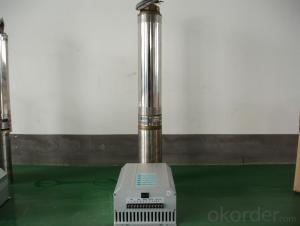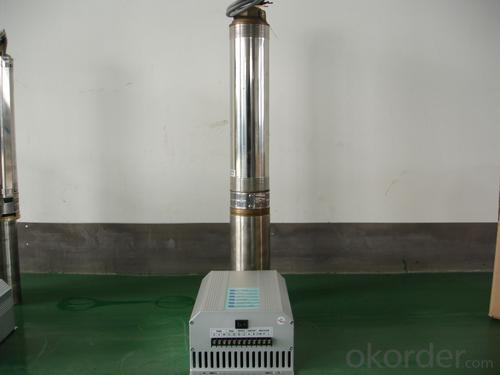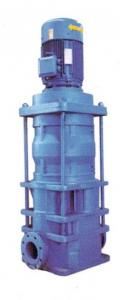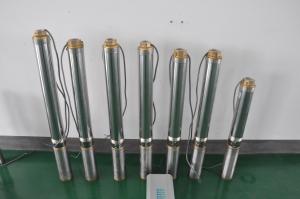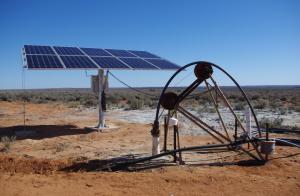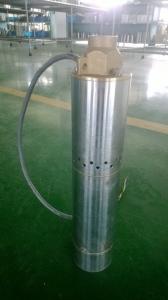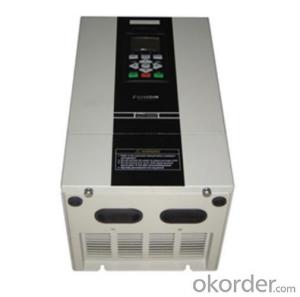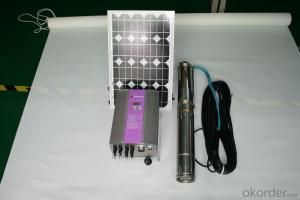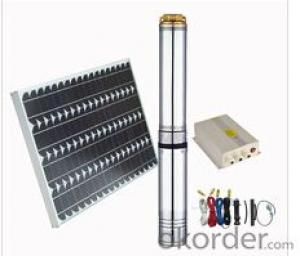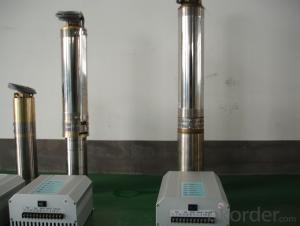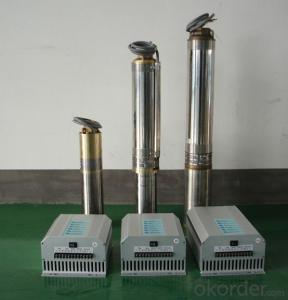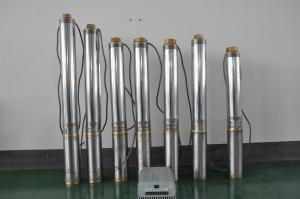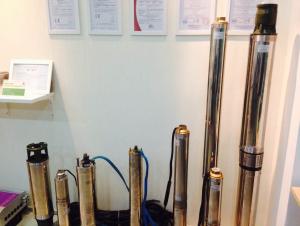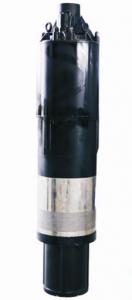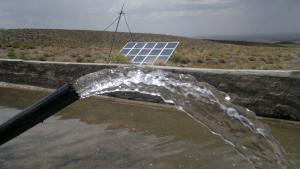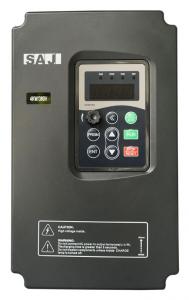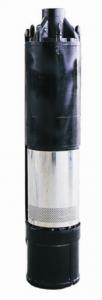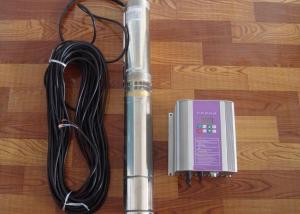Solar Pump Price for Solar Water Pump (110v)
- Loading Port:
- China Main Port
- Payment Terms:
- TT OR LC
- Min Order Qty:
- -
- Supply Capability:
- -
OKorder Service Pledge
OKorder Financial Service
You Might Also Like
Item Description :
This superb new addition to our solar fountain range comes with a 10w solar panel,and a powerful fountain pump that is capable of producing fountains of up to 2m in height. As well as being easy to set up and use.Instruction manual is supplied for assembly and maintenance.
Solar Fountain Key Features :
Powered by direct sunlight
No high voltage electric mains required
Safe for children
Max. height of fountain: 2M
Max. flow capacity: 800 L/H(176 GAL)
10W Polycrystalline solar panel included
18V DC brushless pump
Solar Pump Features :
Can produce fountains up to : 2M (tube height) 1.4M (fountain height)
Comes with multiple nozzle accessories
Cable Length : 5M
Solar Panel Features :
10W peak power.
Polycrystalline highly efficient solar panel
Comes mounted in aluminium frame
Comes with ground stake and rotating knob so you can angle your panel toward the sun
What You Will Get :
10W solar panel
Solar pump
Ground Sake
Nozzle accessories
Precautions :
DO NOT alter or change the product itself or its components
Operate pump in freshwater only, never above 50 degrees celsius
Keep away from flammable liquids
Do not connect to any other power supply other than the included
- Q: Can a solar pump be used for fountain or waterfall features?
- Yes, a solar pump can be used for fountain or waterfall features. Solar pumps are designed to be powered by solar energy, which means they do not require any electricity from the grid. This makes them an ideal choice for outdoor water features such as fountains or waterfalls, where running electricity can be difficult or expensive. Solar pumps are typically easy to install and operate, and they can provide a constant flow of water to create beautiful and soothing water displays. Additionally, using a solar pump for a fountain or waterfall is environmentally friendly since it utilizes renewable energy and reduces reliance on traditional electricity sources.
- Q: Are there any government incentives or subsidies for installing a solar pump?
- Installing a solar pump is eligible for government incentives and subsidies. Governments worldwide recognize the significance of renewable energy and the advantages of utilizing solar power for water pumping systems. These incentives and subsidies are designed to promote the adoption of solar pumps as an eco-friendly and sustainable alternative to traditional systems. The availability of specific incentives and subsidies may vary depending on the country or region. However, they typically include financial aid, tax credits, grants, and low-interest loans. For instance, in the United States, the federal government provides a federal investment tax credit (ITC) that enables individuals and businesses to deduct a portion of their solar pump installation costs from their federal taxes. Some states may even offer additional incentives alongside the federal ITC. Moreover, international organizations like the World Bank offer funding and support for solar pump installations in developing nations. These initiatives aim to enhance access to clean water and boost agricultural productivity in areas with unreliable or nonexistent electricity supply. To obtain detailed information about the incentives and subsidies available in your area, it is recommended to consult local government agencies, energy departments, or renewable energy associations. By taking advantage of these government programs, individuals and businesses can significantly reduce the initial expenses of installing a solar pump while contributing to a more sustainable future.
- Q: Can a solar pump be used for water supply in off-grid schools?
- Yes, a solar pump can be used for water supply in off-grid schools. Solar pumps are a sustainable and cost-effective solution for remote locations without access to electricity. They can harness solar energy to power the pump and provide a reliable water supply for the school, ensuring access to clean water for the students and staff.
- Q: How much sunlight is needed to operate a solar pump effectively?
- The amount of sunlight needed to operate a solar pump effectively varies depending on the specific pump and its power requirements. However, in general, solar pumps typically require a minimum of around 4-5 hours of direct sunlight per day to operate efficiently.
- Q: How does a solar pump handle water with high levels of dissolved solids?
- A solar pump can handle water with high levels of dissolved solids by utilizing a filtration system. The pump will first draw the water through a pre-filter, which helps remove larger particles and sediments. Then, the water passes through a reverse osmosis or nanofiltration membrane, which selectively filters out dissolved solids, minerals, and impurities. This process ensures that the water pumped by the solar pump is clean and suitable for various applications.
- Q: Can a solar pump be used for water supply in residential communities or housing complexes?
- Yes, a solar pump can be used for water supply in residential communities or housing complexes. Solar pumps utilize energy from the sun to pump water, making them an environmentally friendly and cost-effective solution for providing water in areas with no access to electricity. They can be used to pump water for various purposes such as drinking, irrigation, and household use, making them suitable for residential communities or housing complexes.
- Q: How does a solar pump handle water pressure?
- A solar pump handles water pressure by utilizing the power generated from solar panels to operate a motor or pump. The pump is designed to handle the specific water pressure requirements of the system, ensuring efficient water delivery while maintaining the necessary pressure levels.
- Q: What is the difference between a submersible and surface solar pump?
- A submersible solar pump and a surface solar pump are two types of solar-powered pumps used for water pumping purposes. The main difference between these two is their placement and operation. A submersible solar pump is designed to be placed underwater, typically in a well or a borehole. It consists of a pump unit and an electric motor, both of which are submerged in the water. The pump draws water from the source and pushes it to the surface. Submersible pumps are commonly used when the water source is deep underground, and they have the advantage of being more efficient as they do not require suction to lift the water. On the other hand, a surface solar pump is placed above the ground and does not require submersion. It consists of a pump unit and a solar panel that is installed nearby. The pump draws water from a source such as a pond, river, or tank and delivers it to the desired location. Surface pumps are suitable when the water source is easily accessible and relatively close to the surface. In terms of operation, submersible pumps are generally more powerful and can pump water at higher pressures and depths compared to surface pumps. They are also more suitable for continuous operation as they are protected from weather elements and are not prone to cavitation (formation of air bubbles that can damage the pump). Surface pumps, while not as powerful, are easier to install, maintain, and repair as they can be easily accessed above the ground. In summary, the main difference between a submersible and surface solar pump lies in their placement and operation. Submersible pumps are submerged in water, suitable for deep water sources, and offer higher pressure and depth capabilities. Surface pumps, on the other hand, are placed above ground, suitable for shallow water sources, and offer easier installation and maintenance. The choice between these two types of pumps depends on the specific requirements and characteristics of the water source.
- Q: What is the role of sensors in a solar pump system?
- The role of sensors in a solar pump system is to monitor and measure various parameters such as water level, pressure, temperature, and flow rate. These sensors provide real-time data to the system controller, allowing it to optimize the pump's performance, ensure efficient water usage, and prevent any damage or malfunction. Additionally, sensors help in detecting any faults or abnormalities in the system, facilitating timely maintenance and troubleshooting.
- Q: Can a solar pump be used for water treatment systems?
- Yes, a solar pump can be used for water treatment systems. Solar pumps are commonly used in water treatment systems as they provide a sustainable and environmentally friendly solution. They can effectively pump water from various sources such as wells, rivers, or lakes, which can then be treated for purification purposes. The use of solar energy to power the pump reduces dependency on electricity grids and minimizes operational costs, making it a feasible option for water treatment systems in remote areas.
Send your message to us
Solar Pump Price for Solar Water Pump (110v)
- Loading Port:
- China Main Port
- Payment Terms:
- TT OR LC
- Min Order Qty:
- -
- Supply Capability:
- -
OKorder Service Pledge
OKorder Financial Service
Similar products
Hot products
Hot Searches
Related keywords
